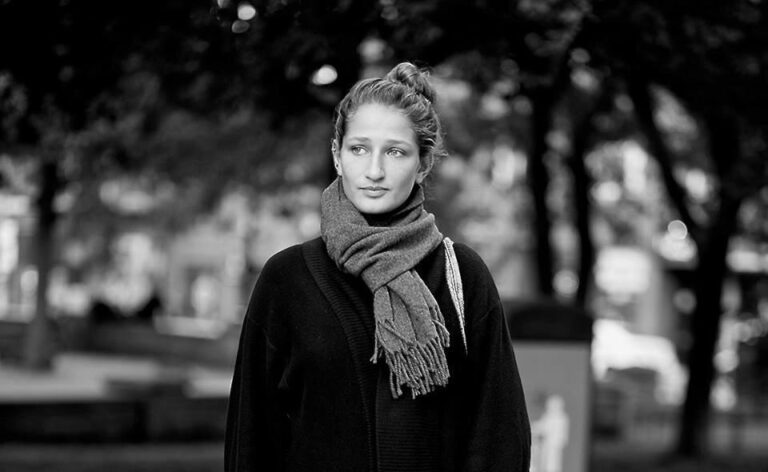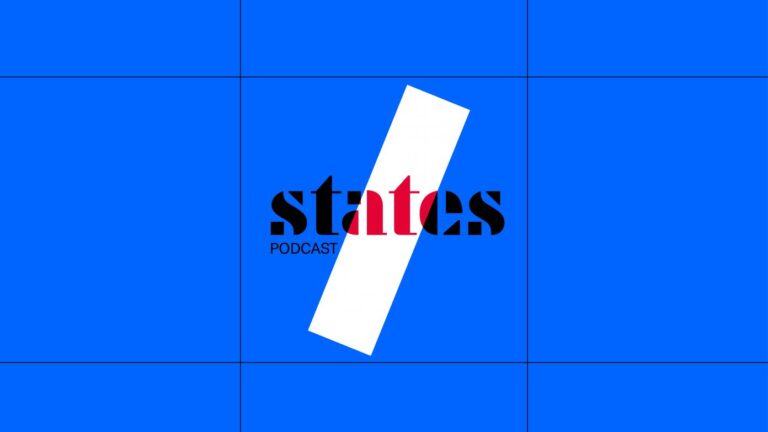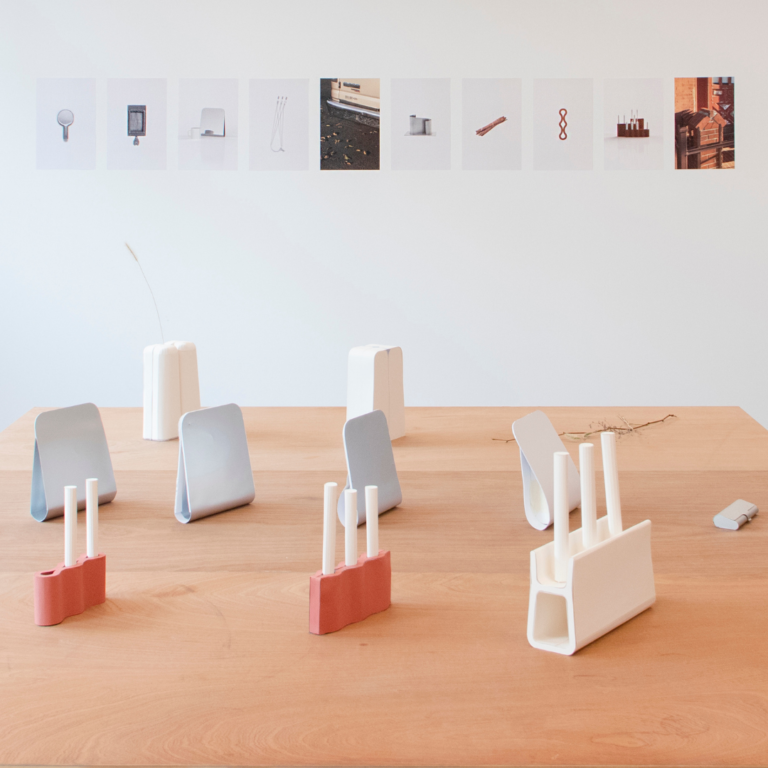
Judith Henon and Sarah Schleuning: “One can only imagine the aesthetic shock caused by the discovery of Islamic art in the West”
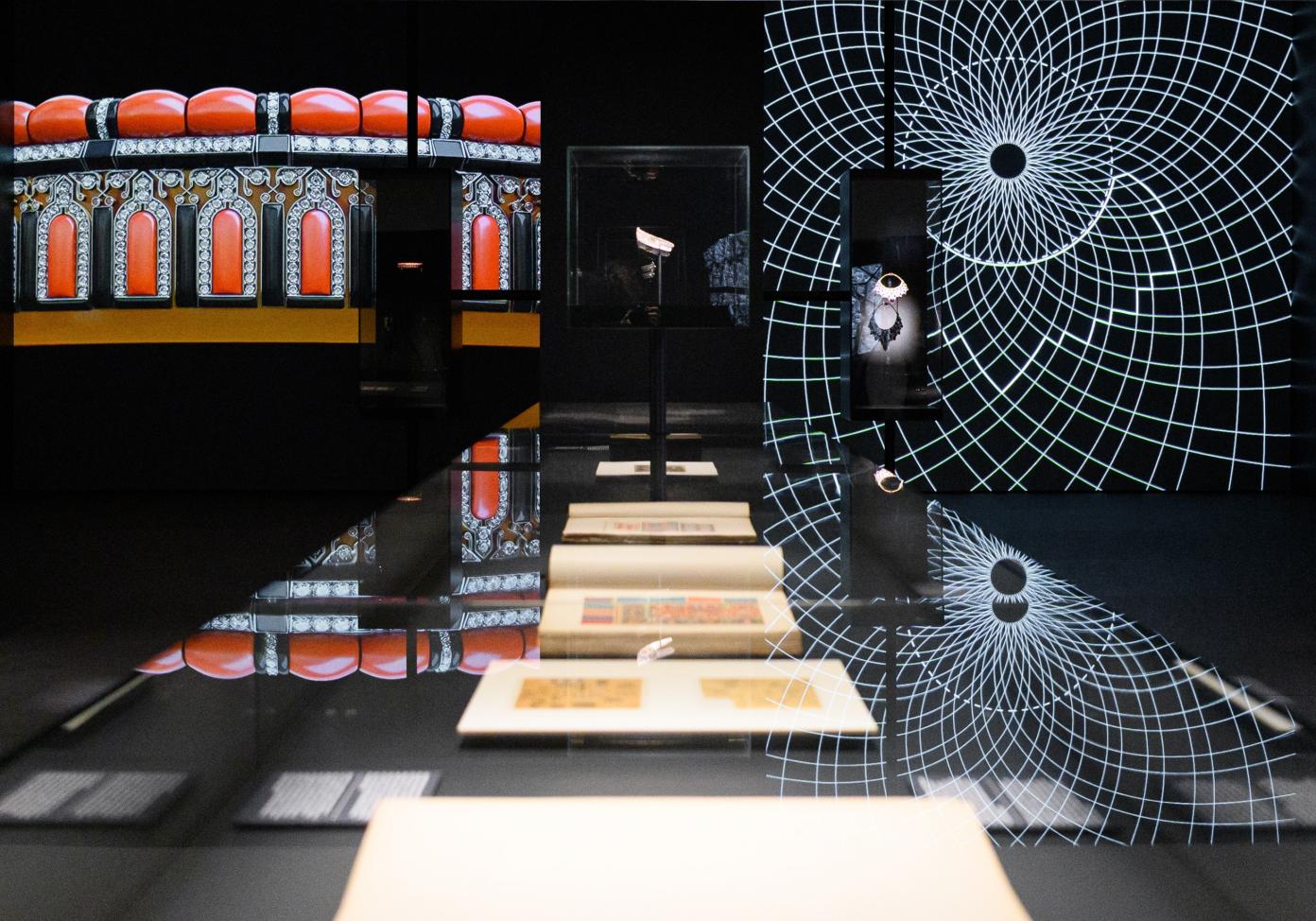
View of the exhibition "Cartier and Islamic Art: In Search of Modernity" at the Dallas Museum of Art; photo by Daniel Salemi, courtesy of Cartier
By Raphaël Bourgois
In a joint interview, Curator and Deputy Director of the Department of Islamic Art at the Musée du Louvre Judith Henon, and Sarah Schleuning, the Margot B. Perot Senior Curator of Decorative Arts and Design at the Dallas Museum of Art (DMA), discuss the scientific, historical, and contemporary issues surrounding the exhibition “Cartier and the Arts of Islam: In search of Modernity.”. The objective is to understand, beyond the aesthetic interest, what this exhibition, which was first presented in Paris, tells us about the place of Islamic arts at the time of the Cartier brothers and their place today in France and the United States.
Let us begin perhaps by giving an idea of this exhibition: what does the Louis Cartier’s collection say about the way in which the view of Islamic art was constructed at the beginning of the 20th century?
Judith Henon: The discovery of Islamic art in the early 20th century had a significant influence on Cartier’s designers. At the time, Cartier was famous for its “Garland-style” jewelry but, as of 1904, the new influence contributed to the addition of new forms to its repertoire – pieces inspired by the geometric designs of Islamic art, as seen in books on ornamentation and architecture. Enameled brick decorations from Central Asia and stepped merlons were the defining features of a style that came to be called Art Deco after the Paris exhibition of 1925 (the “Exposition internationale des arts décoratifs et industriels modernes”), which took the Maison Cartier into the modern age. This source of inspiration is apparent in Cartier’s designs throughout the 20th century.
Sarah Schleuning: Cartier and Islamic Art explores the formative influences of Islamic art on Louis Cartier as a collector and, more significantly, on Maison Cartier’s production of jewelry and precious objects from the early 20th century until today. Paris, at the dawn of the 20th century, was a catalyst for creativity, especially for Louis Cartier (1875–1942) and the Maison he pivoted toward modernity. As European powers expanded into the Middle East, India, and North Africa, Paris became the center of trade in Islamic art and architectural elements. At the same time, the study of Islamic art was emerging as an academic discipline, with major exhibitions presenting these visual works in a more scientific, formalized manner. The exhibition is therefore organized in four sections, each with multiple galleries, offering comparative groupings of jewelry, objects, and archival materials alongside works of Islamic art drawn from international collections, including the Musée du Louvre, Musée des arts décoratifs, and the Keir Collection of Islamic Art on loan to the Dallas Museum of Art.
How can we describe the Louis Cartier’s collection, what is special about it?
SS: One of the aspects that made this exhibition possible is the immense holdings in the archives that have been an important element of the Maison from its inception. Originally assembled by Louis Cartier’s grandfather and later enriched by Louis, the study library contains anthologies of decorative ornaments, along with art history books, exhibition catalogs, and numerous publications about Islamic art and architecture. These included Owen Jones’s The Grammar of Ornament (1856), as well as the works of well-known French historians of design, including Adalbert de Beaumont, Eugène Collinot, and Albert Racinet. Louis appears to have annotated several of the books, marked with an “x” and sometimes commented on what piqued his interest. The books were, and still are, made available to Cartier designers as a source of inspiration. The library sparked ideas that would be transformed and recombined into new creations.
JH: In addition to the items he purchased to add to Cartier’s stock of apprêts (fragments of existing jewelry or objects, incorporated into new creations), Louis amassed a private collection of Islamic art from the 1910s onward. This collection, dispersed after his death, was never published or fully inventoried; it was reconstructed, as Sarah just mentioned, thanks to the Cartier archives and to the catalogues of the first major exhibitions of Islamic art, which featured pieces lent by Louis. Louis’s private collection focused on 16th- and 17th-century Persian and Indian arts of the book and precious inlaid objects. It reflects his informed taste and love of books. At a time when manuscripts were most often taken apart to remove the paintings, he collected complete books; in fact, he owned a great many masterpieces of Persian manuscripts, some of which are now held by Harvard’s Fogg Museum.
SS: The arrival of Louis Cartier into the family business in 1898 marked a turning point for the company. The Maison set up a studio for designers who, under his artistic direction, would give birth to the Cartier style. Louis also photographed works from his personal art collection for the designers to study. Similar to today, the combined work of Louis Cartier and his designers is documented through initial sketches, execution drawings, and creative notes. Most notably is the cahier d’idées, or idea notebook. The Maison also photographed all its jewels as they left the workshops. A large collection of these photographs, including glass plate negatives, document the history of production, as well as some of Louis’s private art collection. Plaster casts of the finished works provided a 3D record to complement the photography which was done by the Maison in the early 20th Century. Inclusion of the plasters is unique to the Dallas presentation.
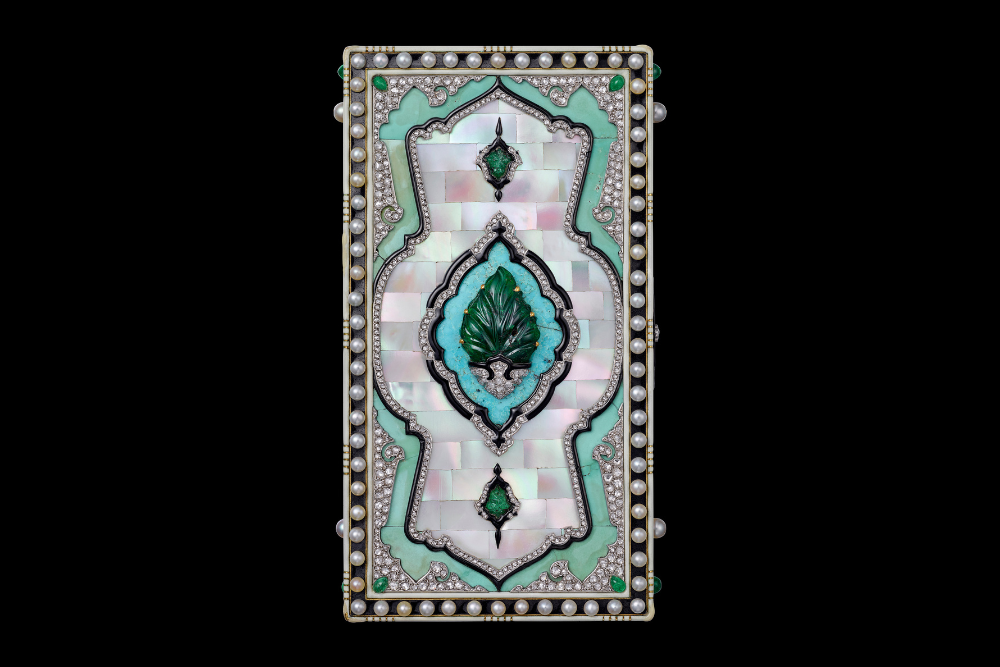
Vanity Case from 1924, Nils Herrmann, © Cartier
In 1903, the Musée des arts décoratifs in Paris held a major exhibition of Muslim art. Was it freed from orientalism, this vision of an orient fantasized by the European painters of the 19th century?
JH: The “Exhibition of Muslim Art” held at the Musée des arts décoratifs in Paris in 1903 was the first scientific exhibition of its kind. It was curated by Gaston Migeon, a young curator at the Louvre and a leading figure among the connoisseurs of Islamic art, who endeavored to raise it to the status of a scientific discipline. With the support of the Union centrale des arts décoratifs (the precursor of the Musée des arts décoratifs) and a network of Parisian collectors, he compiled a rigorous selection of works of art, in stark contrast with the cheap Orientalism of previous exhibitions.
SS: In the early 20th century, designers and firms, including Maison Cartier, had opportunities to discover Islamic art thanks to several European museums. Exhibition organizers intended to expose visitors to unfamiliar motifs, techniques, and materials. As George Marteau stated about the pivotal 1903 exhibition of Islamic art, Exposition des arts musulmans, at the Musée des arts décoratifs, Paris: “One’s eyes were not truly open until 1903.” While this watershed exhibition of course cannot be fully divorced from the surrounding visions and ideas of the East that pervaded 19th century Europe, it did signal a shift in curatorial approach by applying a more scientific and rigorous analysis to objects’ formal characteristics. Its success led to a second exhibition in 1907. The importance of these exhibitions, and those that followed, is two-fold. They sparked curiosity and admiration for the masterful execution of Islamic art, and they created a generation of collectors like Louis himself, who valued the importance of sharing his personal holdings with the public and his own designers.
A word more specifically about Louis Cartier, his role and what we know of his vision of the relationship between ancient Islamic art and modernity?
JH: Louis was constantly on the lookout for new ideas for the Maison Cartier. He explored many other fields, including Ancient Egypt, and Japanese and Chinese art, examples of which featured in his private collection. We have nothing written by him on Islamic art and architecture, but he expanded the Cartier library with a well-stocked section on the subject and, in the early 20th century, amassed a private collection that he made available to his designers.
SS: It is difficult to date the start of Louis Cartier’s personal collection of Islamic art because he regularly purchased works on behalf of the Maison and never published his collection, which was dispersed after his death as Judith pointed out. Portions of his collection have been reunited in this exhibition, thanks to the Maison Cartier’s archives (stock books, invoices, glass plate negatives) and to the records of exhibitions to which he was a lender.
The turn from the 19th to the 20th century was an extraordinary time of artistic proliferation, when Impressionism, Fauvism, Cubism, and finally, Abstraction imposed a new look and new aesthetics. We know for example the importance of African arts as a source of inspiration. What is then the place of Islamic arts?
SS: Artists are inspired by, and draw upon, sources across time, geography, and cultures. There is a cyclical nature to the way inspiration and creativity flows; sometimes ideas evolve and other times there are transcendent shifts. At the dawn of the 20th century, the introduction of the aesthetic elements of Islamic art through exhibitions, publications, travels, and personal collections fueled new ideas and possibilities at Cartier. The Maison began to conceptualize and execute a multiplicity of designs filtered through colors, materials, shapes, and techniques. They mined artistic elements from the past, both from Cartier’s own archives and from original source materials, in pursuit of modern innovation and contemporary trends. Today, Islamic art still inspires Cartier’s designers, and the Maison continues to explore innovative design arcs—an endless rotation of evolution and revolution—in their creations.
JH: As regards the 19th century, the influence of Islamic art has already been studied, and its role as a model and source of inspiration was highlighted in the magnificent exhibition Purs décors ? that was held at the Musée des arts décoratifs in 2007. The research we carried out for the exhibition showed us the influence of Islamic art on Cartier creations, but also in fashion, art deco, publishing etc.
Once this historical and scientific framework has been established, what are the museography choices for exhibiting these issues? What are the important choices for showing this collection, and are they the same in Paris and in Dallas?
JH: The Diller Scofidio + Renfro (DS+R) design studio suggested a streamlined display that showcased the artworks, with a strong emphasis on multimedia installations. The challenge was to help visitors understand the creative process, and to combine works of very different sizes and materials: Islamic artworks (paintings, ceramics, wood, metals), documents, drawings (including miniatures), and jewelry.
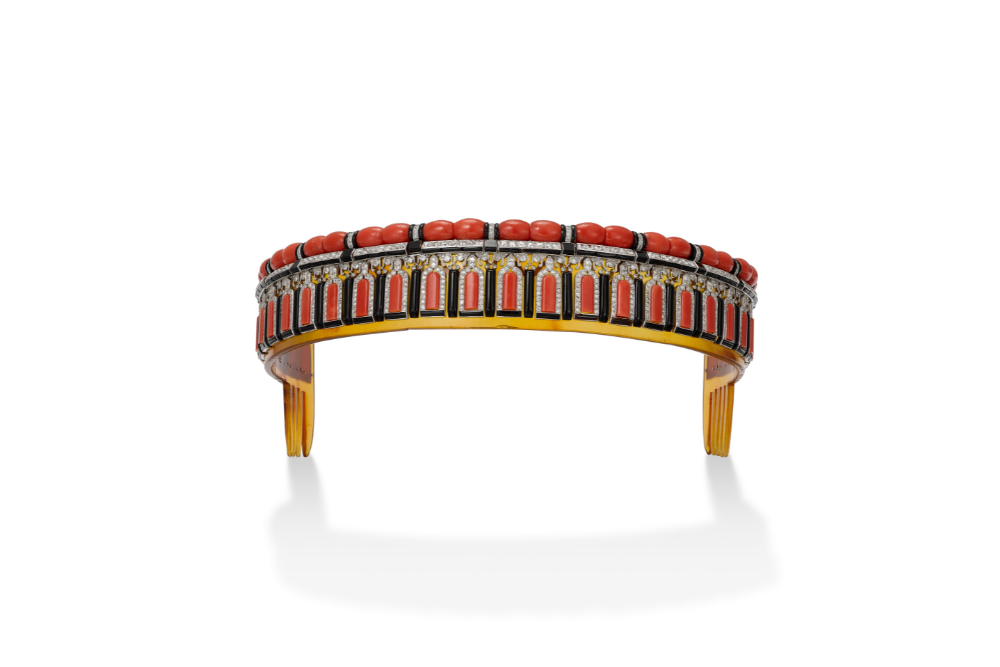
Bandeau from 1922, Vincent Wulveryck, © Cartier
The exhibition design choices were guided by the venues. The Louvre and the DMA are very different places, in terms of architecture, and I think that the exhibition reflects that.
SS: Like the exhibitions of the early 20th century, Cartier and Islamic Art: In Search of Modernity aspires to inspire. In the Dallas installation in collaboration with Elizabeth Diller, follows a narrative path incorporating 15 digital experiences including animations that expand the curatorial narrative. We also chose to house the individual information about the over 400 objects in a booklet, encouraging closer looking with the hope for connections to be made through the visitors’ own senses. This is also a callback to the watershed exhibitions of the early 20th Century of Islamic Art in Europe, which marked the shift toward both a more modern, minimalist aesthetic that focused attention on individual objects and a more scientific approach to the objects displayed.
On the much-debated issue in the United States, and less so in France, of “cultural appropriation”, the exhibition shows how the Cartier designers were inspired by Islamic art. How do you see this distinction between inspiration and appropriation?
SS: Cartier’s designers found inspiration in elements of Islamic art and design, adapting and transforming them into a new stylistic language shaped also by the designers’ own ideas and visions. While rooted in admiration, this borrowing of course cannot be fully divorced from the contexts of French imperialism and colonialism, a power dynamic that is explored in the exhibition catalogue. This exhibition aims to offer a better understanding of Cartier’s design inspirations, where they came from and how they evolved—through collecting, publication, exhibitions, and travel—while also giving direct credit to the original sources of inspiration.
JH: The subject here is creation. Consciously or otherwise, artists are always inspired by something. Motifs and techniques travel, from east to west and west to east, but also within the Islamic world. The aim of the exhibition was to show the extent to which the vocabulary of forms now seen as an integral part of the Maison Cartier is actually indebted to Islamic art. At a time when there was limited access to images, one can only imagine the aesthetic shock caused by the discovery of Islamic art in the West, experienced as a genuine “revelation” by some artists of the time.
Finally, if you had to choose one object from the exhibition, and I’m sure it’s very difficult, but what would it be and why?
JH: I would probably choose the turquoise and mother-of-pearl vanity case. We were able to trace its original source of inspiration thanks to a photo in the Cartier archives: a mirror case or a fragment of a 19th-century Persian box whose classical Islamic design was also used to decorate book bindings. The case was made using a combination of materials that reference the Persian and Indian worlds, major sources of inspiration for Louis Cartier
SS: The 1922 bandeau is a stunning study of architectural forms and color miniaturized and imagined as an arcade orarch Incorporating onyx, coral, platinum, gold, and diamond elements all delicately attached to tortoise shell, this bandeau is a study in detail, artistry, creative inspiration, and modern expression.
The exhibition Cartier and Islamic Art: In Search of Modernity is co-organized by the Dallas Museum of Art and the Musée des Arts Décoratifs, Paris, in collaboration with the Musée du Louvre and with the support of Cartier. The exhibition will be on until September 18, 2022.
Judith Henon is Curator and Assistant to the Director of the Department of Islamic Arts at the Louvre. Sarah Schleuning is Interim Chief Curator and The Margot B. Perot Senior Curator of Decorative Arts and Design at Dallas Museum of Art.

